
Billion-Dollar Brain is a 1966 Cold War spy novel by Len Deighton. It was the fourth to feature an unnamed secret agent working for the British WOOC(P) intelligence agency. It follows The IPCRESS File (1962), Horse Under Water (1963), and Funeral in Berlin (1964). As in most of Deighton's novels, the plot of Billion Dollar Brain (1967) is intricate, with many dead ends.

Sidney George Reilly —known as "Ace of Spies"—was a Russian-born adventurer and secret agent employed by Scotland Yard's Special Branch and later by the Foreign Section of the British Secret Service Bureau, the precursor to the modern British Secret Intelligence Service (MI6/SIS). He is alleged to have spied for at least four different great powers, and documentary evidence indicates that he was involved in espionage activities in 1890s London among Russian émigré circles, in Manchuria on the eve of the Russo-Japanese War (1904–05), and in an abortive 1918 coup d'état against Vladimir Lenin's Bolshevik government in Moscow.

Vulture in the Sun is a 1971 spy thriller novel by the British writer John Bingham. The protagonist is an agent of British intelligence operating out of Cyprus. It features the fictional head of British intelligence Ducane, who recurs in several of the author's novels.

The Double Agent is a 1966 spy thriller novel by the British writer John Bingham. It features the fictional head of British intelligence Ducane, who recurs in several of the author's novels. It was a runner-up for the Gold Dagger award.
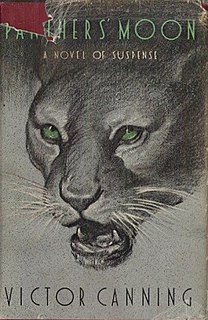
Panther's Moon is a 1948 spy thriller novel by the British writer Victor Canning. It was his second post-war novel, following The Chasm, as he had largely been taken a break from writing during his wartime service.

The Curse of Doone is a 1928 mystery thriller novel by the British writer Sydney Horler. It also has element of horror about it. It was published in America in 1930 by The Mystery League.

I'll Say She Does is a 1945 thriller novel by the British writer Peter Cheyney. It is the tenth in his series of novels featuring the FBI agent Lemmy Caution. Later editions of the book are generally titled I'll Say She Does!
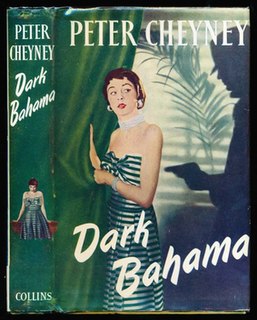
Dark Bahama is a 1950 thriller novel by the British writer Peter Cheyney. It was the second in a trilogy featuring the private detective Johnny Vallon, a hard-drinking former army officer. The story also features Quale, the head of British intelligence who appears on several other novels by Cheyney. Much of the action takes place in a fictional island in the Bahamas and nearby Miami in Florida.

Ladies Won't Wait is a 1951 spy thriller novel by the British writer Peter Cheyney. It is a sequel to the 1945 novel Sinister Errand and portrays the continued adventures of Michael Kells, a half-American, half-British secret agent. It was published in the United States under the alternative title Cocktails and the Killer.
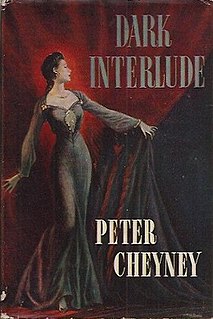
Dark Interlude is a 1947 spy thriller novel by the British writer Peter Cheyney. It features a British secret agent Shaun Aloysius O'Mara and his superior Quale, a recurring figure in Cheyney's novels.

Dark Duet is a 1942 spy thriller novel by the British writer Peter Cheyney. Cheyney had become known for his hardboiled crime thrillers featuring Lemmy Caution and Slim Callaghan, but this novel was his first fully-fledged espionage novel. The novel is set in wartime London, Lisbon and Ireland. It was published in the United States with the alternative title The Counterspy Murders.
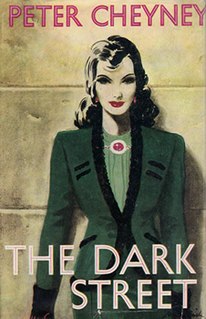
The Dark Street is a 1944 thriller novel by the British writer Peter Cheyney. It was published in the United States by Dodd, Mead with the alternative title of The Dark Street Murders. It follows on from both the 1942 novel Dark Duet and the 1943 novel The Stars Are Dark and features his recurring head of British counter intelligence Quale as well as the spy Shaun O'Mara. It begins in wartime occupied Paris before moving to London.
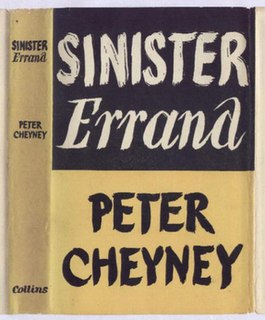
Sinister Errand is a 1945 spy thriller novel by the British writer Peter Cheyney. Cheyney known for his creations Lemmy Caution and Slim Callaghan, introduced a new character the half-American secret agent Michael Kells. It was followed by a sequel Ladies Won't Wait in 1951.

Up the Ladder of Gold is a 1931 thriller novel by the British writer E. Phillips Oppenheim. He dedicated the work to the comedy writer P.G. Wodehouse. It represented the apex of Oppenheim's portrayal of the great man as a dynamic force.

A Lost Leader is a 1906 politically-themed novel by British writer E. Phillips Oppenheim. Later better known for his thrillers, it was one of several novels Oppenheim wrote at the time centred on "social political life". In it, a potential Liberal Party politician, Lawrence Mannering, is lured back from his country estate to London to revive the party's fortunes.

Mysterious Mr. Sabin is a 1898 spy thriller novel by the British writer E. Phillips Oppenheim. It was the first spy novel by Oppenheim, a genre which he came to dominate during the First World War and interwar era. Revolving around a plot of a Frenchman selling British military secrets it became a bestseller, establishing him as a popular writer. It has been described as the novel "that launched Oppenheim's career of xenophobic espionage fantasy". It contains elements of invasion fiction, a common genre theme at the time.
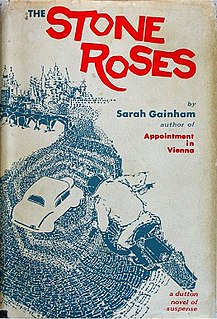
The Stone Roses is a 1959 spy thriller novel by the British writer Sarah Gainham. It is set in Prague shortly after the Communist coup in Czechoslovakia.

The Cold Dark Night is a 1957 spy thriller novel by the British writer Sarah Gainham. Her second novel, it is set at the height of the Cold War when the 1954 Berlin Conference saw the Big Four foreign ministers arrive in the divided city. Gainham had worked in Berlin as a journalist at the time of the Conference.

The Python Project is a 1967 spy thriller novel by the British Victor Canning. It is the third in a series of four novels about Rex Carver, a private detective drawn back into his old profession of espionage. A complex plot which involves a jewel robbery and the exchange of prisoners between the British and Soviet intelligence services takes place in a variety of locations including London, Paris, Libya and the Balearic Islands.

Firecrest is a 1971 spy thriller novel by the British writer Victor Canning. A stand-alone novel, it introduced a more modern, darker and naturalistic style compared to Canning's previous novels. It marked the first appearance of "The Department", a shadowy dirty tricks agency working for the British government which featured in subsequent novels.




















